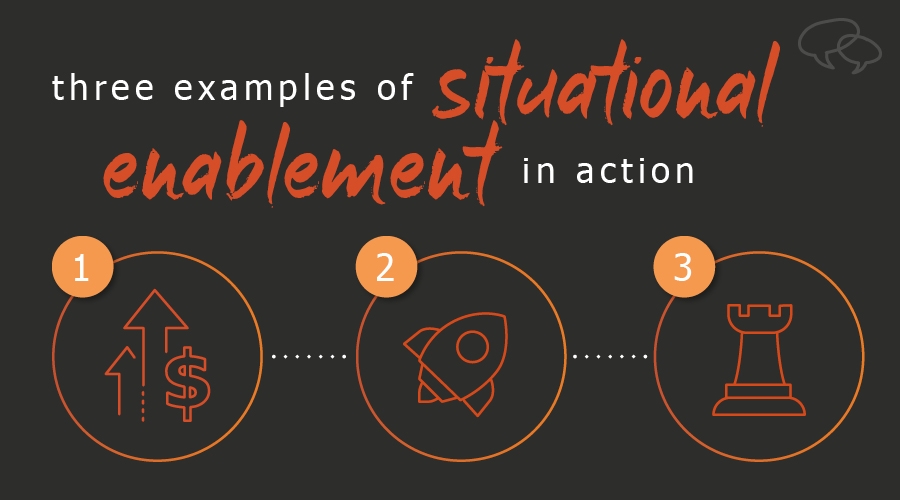
This article describes three examples of Situational Enablement in action.
What is Situational Enablement?
Situational Enablement programs are initiatives that you can roll out quickly when you need to address acute, must-win business challenges and market opportunities.
At the core of Situational Enablement is the integration of tailored messaging, content assets, and relevant skills training to respond quickly and win at that moment. Consider the following three examples.
1. Communicate a Price Increase
At the beginning of the year, one company decided to increase the price of their services—an initiative that would account for seven percent of their growth for the year. To make it happen, they needed to train about 6,000 sellers to deliver that price increase message to their customers.
The Solution
Message: A message specifically designed to persuade customers to pay more without disrupting the relationship so much that they start to shop around. The message was based on an exclusive, tested, and proven framework for communicating price increases.
Content: A “Why Pay More” call guide was created to provide a structure for the conversation. It also included sample email and voicemail messaging content, along with potential questions, objections, and responses.
Training: Micro-training videos were embedded to reinforce key concepts from the company’s popular negotiation skills training. These one-minute knowledge refreshers were linked to the moments in the messaging they specifically supported.
Delivery Timeline: Four weeks from concept to rollout.
2. New Product Launch
A company was poised to release a highly innovative product to the market. The rollout time on the unique offering would typically take a year or more to reach all 10,000 sellers. But they identified a small, 90-day window before the competition would be able to replicate the same service, so it was imperative to launch as quickly as possible.
The Solution
Message: A disruptive and differentiated product launch story was designed to grab prospects’ attention, convince them to change to the new service, and create a clear contrast from the competing alternative. The message was based on an exclusive, tested framework.
Content: A teaser video, sales presentation deck, and call guide were created to help generate demand for a meeting and enable the first call and follow-up.
Training: The message was incorporated into an online training experience focused on skills for disruption and differentiation. It also incorporated an online mission where salespeople had to record themselves delivering the new product message using the skills to demonstrate proficiency.
Delivery Timeline: Six weeks from concept to rollout.
3. Respond to a Competitive Move
One company discovered that top executives from their biggest competitor were aggressively targeting their best accounts. This competitor was hosting executive-level meetings with existing customers to actively derail the relationship. The company needed to immediately respond and ward off this urgent competitive threat.
The Solution
Message: An executive-level, retention-focused message was designed to protect and grow the business with senior decision-makers at key customers. The message was based on an exclusive, tested framework for elevating the conversation to the c-suite.
Content: A detailed “Defend and Expand” messaging document provided the essential talk tracks, including example messages to gain access, presentation and conversational content, as well as objection handling responses.
Training: Micro-training videos focused on key executive conversation techniques were embedded in the document to provide both the story and skills training. A virtual training session, including role-play rehearsal, was conducted and recorded to prep the sales team for making the executive calls.
Delivery Timeline: Three weeks from concept to rollout.
Respond to Situations in Weeks, Not Months
Urgent situations like these require an urgent response. That means aligning the entire organization on the right story and the right skills to tell that story in weeks, not months.
In this blog series, I’m giving you more details on what it looks like to execute Situational Sales Enablement at your company.
Watch our on-demand webinar, The Power of Situational Enablement, to learn more about this new model for training and enabling your team.
Business & Finance Articles on Business 2 Community
(42)